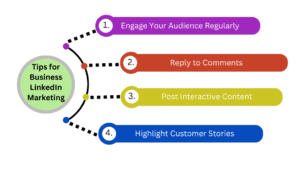What is LinkedIn’s Marketing Strategy?
With the increasing number of B2B marketing, LinkedIn marketing strategies are used to leverage your personal or professional brand, expand your network, and build trust. LinkedIn is no longer the place for thousands of people to look for new jobs or to make new contacts. What was once used for mere brand identity and differentiation has today transformed into a very effective promotional tool, particularly for B2B marketing. Being the largest network of professionals and businesses, with more than 900 million users across the globe, LinkedIn is an incredible opportunity for companies to engage with professionals, service providers, and potential customers.
LinkedIn marketing approach can, therefore, be defined as the process whereby marketing and communication executives design the manner in which companies engage their target audience. The aim is to create awareness of the company’s brands and products that are or can be marketed on LinkedIn. It is meant to gain more traffic, establish rapport, and create prospects.
Why is LinkedIn Marketing Important?
Especially in today’s fast-growing digital environment, marketers usually rely on different social media platforms like Instagram, Twitter, or Facebook. However, LinkedIn gives it a different twist since it is a social professional platform. Here’s why LinkedIn marketing is essential for businesses:
1. Reach a Professional Audience:
The Junto is made up of decision-makers from several industries, CEOs, managers, as well as recruiters on the platform. It’s also an ideal place to advertise directly to people with inherent interest in your industry or services.
2. Boost Brand Authority:
Since LinkedIn is an important platform in the business world, using it to be active helps businesses explain their knowledge in their fields. It allows businesses to share knowledge and become more credible to their readers and audience in general.
3. Lead Generation:
Lead generation is one of the key reasons why LinkedIn is important. Used correctly, LinkedIn is one of the best tools for generating quality business-to-business leads. Remarketing, emailing, and LinkedIn Ads can help in building relationships and turning customers into clients.
4. B2B Networking:
This format favors B2B marketing on LinkedIn because, after signing up for the platform, the businesses can connect with other businesses, industry experts, and decision-makers directly without any third-party interference. It is less saturated by businesses and offers more straightforward access to possibly interested clients and partners compared to other social networks.
5. Targeted Advertising:
LinkedIn offers two types of paid marketing methods, which are LinkedIn Sponsored Content and LinkedIn Ads and both of them have very good targeting features. You can even segment your campaigns by industry, job title, location, company size, and much more, to make sure people see and interact with your campaigns.
6. Increased Website Traffic:
By sharing valuable content, companies generate website, landing page, and blog traffic to a network of highly professional and relevant users, which increases the chance of converting leads.
7. SEO Benefits:
LinkedIn has always been regarded as a powerful social media platform for job seekers, and any posted articles get ranked highly within a few hours of posting on Google search engines.
These are all the points that prove why LinkedIn is important.
Tips for Business LinkedIn Marketing
Establishing a LinkedIn marketing strategy requires more than just occasionally updating a company’s status. Marketing is about creating an agitated existence to appeal to or communicate with the people.
Now that we have a basic understanding of how to use LinkedIn for marketing, let’s take a look at some tips to make that marketing as effective as possible.
1. Engage Your Audience Regularly
There is nothing as important as being consistent while marketing the LinkedIn page. Before updating your status, your content should provide value to the viewers, and you should make several updates frequently. Promote newsworthy company events, convey changes in the company’s services, products, position, or accomplishments, or even disseminate articles containing industry news or the author’s opinions. This is the case because communication allows you to constantly interact with your audience, hence making your brand familiar to them.
-
Frequency:
It is recommended that a business post once or twice a week for starters until the page gains traffic and followers. But remember to vary the frequency of posting as per the mandates of your target group.
-
Content-Type:
Divide the content into text updates, photos, graphic images, links to videos, and links to articles and blog posts. LinkedIn also provides us with the means of creating polls and surveys that will facilitate participation.
Also, by interacting often, you help increase the possibility of the articles you share being circulated and gaining accreditation.
2. Reply to Comments
Engaging with your audience is not just about sharing content; it is also about engaging with your community. If people do comment on your posts and pages, then you should be sure to reply to them as well. This makes them feel that you are interested in what they have to say and that their opinion is important.
-
Timely Responses:
Acknowledge comments just as soon as you can, especially in case of questions or good remarks. Juste un signe d’acceptation peut vous aider à estreut les fondations d’une relation avec votre public.
-
Encourage Discussions:
Use the comments section to further the discussion and start new threads with follow-up questions that have been discussed. This can enhance the interaction and provide your brand with more exposure. Click here to see more insights for your brand.
The practice will help the audience feel that they are interacting with the actual brand, hence making them loyal.
3. Post Interactive Content
It could be attributed to the fact that LinkedIn users are much more inclined towards content that leads to an action. Polls, quizzes, and questions are the kinds of content that make your posts provocative and can engage the audience in the process of active and passive participation.
-
LinkedIn Polls:
Surveys are a great way to quickly get some information from your viewers. They can be employed to seek information on issues touching on the industry, to seek opinions on new products in the market, or to feel the pulse on events within the industry.
-
Quizzes and Challenges:
By creating quizzes or challenges, you generate interaction that can be enjoyable and informative for your business niche. For instance, if you are interested in marketing, you can develop a quiz based on trends in marketing or some issues that marketers face.
Engaging and dynamic content not only increases the interaction but always gives an idea of what others are thinking.
4. Highlight Customer Stories and Testimonials:
Emphasize the positively touching stories or experiences that the customers get when using your products. More often than not, one of the most effective methods of creating trust with your end user is through the use of customers’ experiences and reviews. Potential customers are more comfortable becoming your customers themselves if they know that other people benefit from your product or service.
-
Case Studies:
Submit examples of how your business prevented a problem in a case study and how you dealt with it. It often helps to turn to the basics—to key challenges, solutions, and outcomes.
-
Customer Testimonials:
Use written and, if possible, video testimonials. However, video testimonials are preferable as they are personal and tend to receive more attention on the platform compared to others.
-
User-Generated Content:
Ensure your customers use your brand on the LinkedIn platform, and ensure they comment on your company page. Share these user-generated content pieces again to improve their reach.
Stories relating to customers help to give evidence that would make would-be customers believe in your business entity and try out your products.
5. Track Analytics and Refine Your Strategy
To make your online marketing campaign on LinkedIn, you must monitor your progress using the statistics available on LinkedIn. This way, metrics such as engagement rates, new followers, click-through rates, etc. are observed, and therefore one can tell what will work well and what will not.
-
LinkedIn Analytics:
Engage in an analysis of LinkedIn Page Analytics to determine which of your posts are generating a lot of interest, the type of people who are following you, and the trends that you are noticing over a given period.
Identify which posts are generating the most interaction and refine your content strategy accordingly.
-
Follower Insights:
LinkedIn gives you some data about your followers, including insights into them as workers and individuals like job titles, industries, and geographic distribution. Then apply the data on interest and needs to optimize your content.
-
A/B Testing:
It’s beneficial to experiment with a variety of posts and headlines that would stand the best chance of working. This also enables you to get a clue on the best way to go about it so that your content is effective.
In this way, you can make sure that your LinkedIn marketing experience yields the best outcome possible every time you implement your marketing strategies in your LinkedIn account.
Additional LinkedIn Marketing Strategies for Success
Here are a few more strategies to help your business maximize its presence on LinkedIn:
1. Optimize Your Company Page:
Having the right description, logo, keywords, and attractive banner for your LinkedIn company page will serve your brand best.
2. Use LinkedIn Ads:
Some LinkedIn advertising includes sponsored content, message Ads, and text Ads. They may also assist you in identifying a somewhat more specific audience.
-
Leverage Employee Advocacy:
Let your employees circulate corporate content on their linked-in accounts. The problem with the latter is that employee advocacy can reach a greater audience and is more personal to a brand.
-
Join LinkedIn Groups:
LinkedIn Groups in the specific industry should be joined to increase the network base and provide the opportunity for human interaction and sharing knowledge in the specific industry, especially in the discussion boards.
-
Collaborate with Influencers:
Seeking help from industry players on LinkedIn can be a good strategy for improving the perception of your brand among LinkedIn followers.
Conclusion
LinkedIn marketing is an effective way of marketing to the professionals who use the website in their business or career. Through constant LinkedIn marketing strategies, responding to the audience, and sharing the real experiences of customers, organizations can build fruitful relationships to make profits. Always remember to track your performance using analytics and further adjust your motion to fit the platform environment for long-term stability.
When you promote your business on LinkedIn properly, you are sure to capture the complete value in this professional-oriented platform, with the potential to put your business at the forefront and unlock other opportunities.






